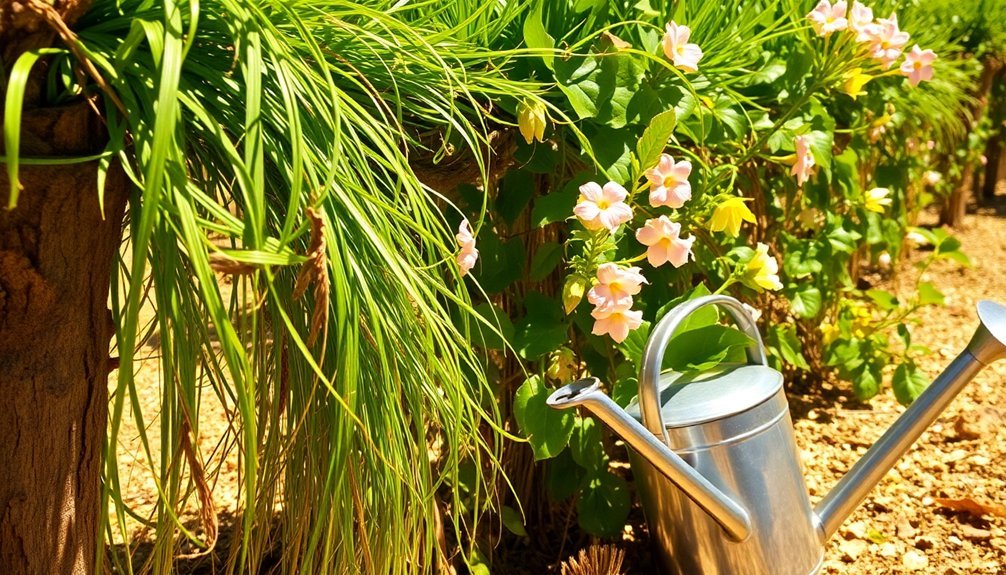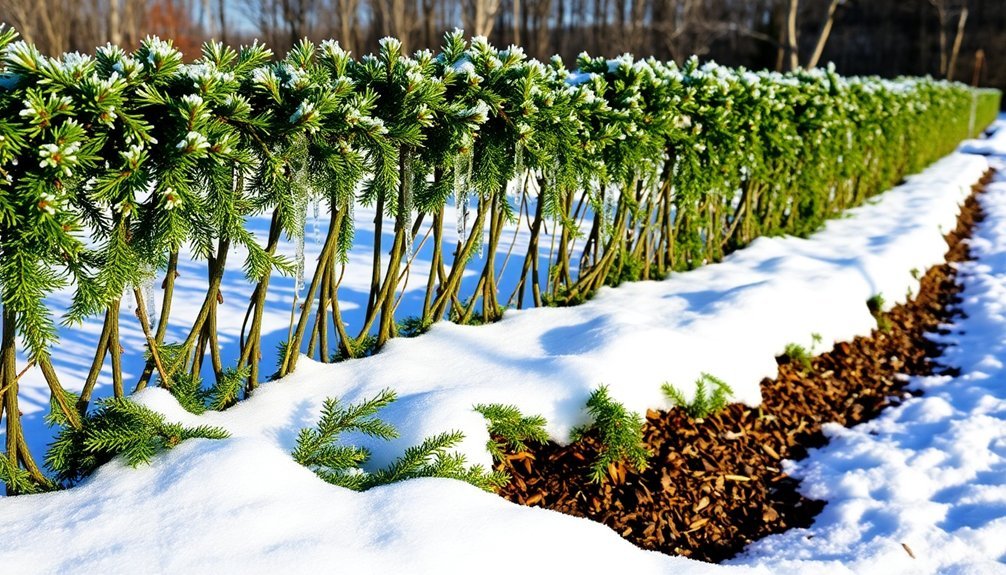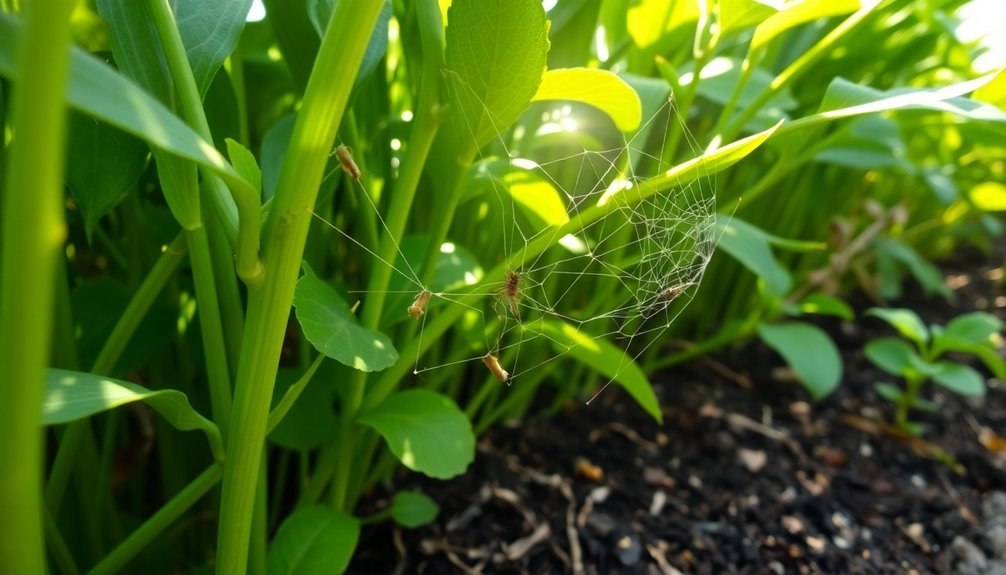Natural fences require seasonal care cycles because they face unique challenges year-round. In winter, frost weakens roots while snow adds weight to branches. Spring demands nutrient replenishment and pruning, while summer brings heat stress requiring strategic watering. Fall preparation involves clearing debris and applying protective coatings. By adjusting your maintenance approach with the seasons, you'll maintain a healthier, more resilient living boundary. The following guide reveals exactly how to time these critical interventions.
The Impact of Seasonal Changes on Living Fence Structures

While homeowners often overlook seasonal effects on their property boundaries, living fences face unique challenges throughout the year that directly impact their structural integrity and longevity.
Winter's frost and ice can weaken tree roots, potentially destabilizing your entire fence structure, while snow accumulation adds weight that may break branches.
You'll need to monitor these living barriers during freeze-thaw cycles when fence posts commonly develop cracks.
Summer brings rapid growth requiring regular pruning to maintain shape and prevent encroachment.
Don't forget autumn's falling leaves, which demand cleanup to prevent moisture-related decay and pest problems. Winter installation provides easier access to your fence perimeter without the obstacle of overgrown plants blocking your maintenance path.
For young trees in your living fence, provide protection from animals and harsh winds during winter months to guarantee they'll develop into strong boundary elements.
Spring Revival: Essential Care for Natural Barrier Growth
As spring awakens the dormant landscape, your natural fence requires attentive care to guarantee robust growth throughout the coming seasons. Start by evaluating winter damage and pruning dead branches to stimulate new growth. Apply organic, slow-release fertilizers to replenish essential nutrients while introducing mycorrhizal fungi to enhance root development. Thorough inspection helps identify invasive species that might disrupt your living fence's ecosystem.
| Care Task | Timing | Benefits |
|---|---|---|
| Pruning | Early Spring | Shapes plants, stimulates growth |
| Fertilizing | Mid-Spring | Boosts nutrient availability |
| Mulching | After fertilizing | Retains moisture, reduces weeds |
| Pest inspection | Bi-weekly | Prevents infestations early |
Don't forget to adjust your watering schedule as temperatures rise. Choose dense foliage plants like boxwood or native species that support local biodiversity while providing privacy. Incorporate a variety of textures and colors for aesthetic appeal.
Summer Heat Management for Plant-Based Boundaries

When summer temperatures soar, your natural fence faces unique challenges that require proactive management. Heat stress can quickly damage plant materials, causing browning and drying of leaves that compromise your boundary's integrity.
Implement strategic watering schedules to maintain ideal moisture levels without promoting rot. Consider adding shade through nearby trees or installing temporary covers during peak heat hours. Unlike vinyl fencing which remains cool to touch even on hot days, natural fences need extra protection from extreme heat.
For bamboo or willow fences, regular inspections help catch insect infestations early before they cause significant damage.
Your fence can actually help cool your property through evapotranspiration if you've selected appropriate species. Plants with larger leaves create beneficial microclimates through increased shade and improved air circulation.
Regular pruning not only maintains appearance but also guarantees proper airflow that prevents fungal issues common in summer's humid conditions.
Autumn Preparation: Fortifying Natural Fences Before Winter
You'll need to clear fallen leaves and twigs from your natural fence's base to prevent rot and structural weakness during winter months.
Apply a protective weather coating to wooden elements, choosing a sealant appropriate for your local climate conditions. Regularly checking for cracks and splits in the wood helps identify vulnerable areas that need immediate attention.
This autumn maintenance not only extends your fence's lifespan but also reduces costly repairs that might become necessary if moisture penetrates the wood during freeze-thaw cycles.
Clearing Fallen Debris
The accumulation of fallen leaves, branches, and debris around natural fences creates perfect hiding spots for pests and potential breeding grounds for fungal diseases.
Starting with a layered cleanup approach will help you maintain the health and structure of your living fence while preventing long-term damage.
Begin by using appropriate tools like rakes or leaf blowers to gently remove surface debris without disturbing plant roots. This careful removal prevents mold formation and reduces pest habitation opportunities.
As you clear debris, take time to inspect your fence plants for signs of disease or damage that should be addressed before winter sets in.
Consider composting collected organic materials rather than discarding them, returning valuable nutrients to your garden while supporting your fence's ecosystem through responsible waste management. Just as writers are encouraged to move beyond the write what you know limitation, gardeners should explore creative solutions for fence maintenance that go beyond conventional practices.
Protective Weather Coating
After clearing away debris, your natural fence requires protective armor against winter's harsh assault.
Apply a weather-resistant coating that offers UV protection, water repellency, and defense against mold and insects. Choose products specifically formulated for your fence's wood type—cedar and pressure-treated lumber have different needs.
If it's been 2-3 years since your last application, now's the time to refresh the sealant.
Focus on areas prone to moisture accumulation and sun exposure. Don't forget to lubricate hardware to prevent freezing and guarantee functionality throughout winter. Be sure to also trim any overhanging branches that could potentially break under snow and ice weight, causing damage to your fence structure.
This protective coating will shield against the damaging freeze-thaw cycle, reduce snow weight stress, and maintain structural integrity.
With proper autumn preparation, you'll greatly extend your fence's lifespan and minimize costly repairs come spring.
Winter Protection Strategies for Living Fence Materials

To protect your living fence during winter's harshest conditions, select frost-resistant plants like juniper, arborvitae, or holly that naturally withstand freezing temperatures.
You'll need to regularly remove accumulated snow from branches and stems to prevent breakage from excessive weight. Consider that most snow will gather on the downwind side of your living fence, making this area a priority for snow removal maintenance.
Strategic placement of supports or stakes near vulnerable sections can provide additional reinforcement against heavy snow loads and strong winter winds.
Frost-Resistant Plant Selection
Selecting frost-resistant plants for your living fence guarantees year-round privacy and visual appeal, even during harsh winter conditions. Consider evergreen options like holly (*Ilex x meserveae*) and yew, which maintain their dense foliage through winter while offering excellent cold tolerance.
Arborvitae thrives in USDA Zones 3-7, making it perfect for colder regions, while juniper varieties like 'Blue Arrow' (Zones 4-8) provide stunning bluish foliage year-round. North Pole arborvitae varieties grow 10-15 feet tall and create excellent privacy screens when properly spaced.
For moderate frost areas, boxwood 'Wintergreen' offers reliable screening but may need protection during extreme cold.
The ideal frost-resistant plants share key characteristics: evergreen foliage, dense growth habits, and adaptability to fluctuating soil moisture.
These qualities guarantee your living fence remains functional and attractive regardless of frost severity.
Snow Load Management
Winter's heavy snow presents a significant challenge for living fences, requiring strategic management to prevent costly damage and maintain structural integrity.
You'll need to guarantee your natural barrier can withstand the additional weight that accumulates during snowfall.
Install cross-bracing between posts to distribute snow weight evenly across your living fence structure.
For woody shrubs and trees, gentle removal of heavy snow using soft-bristled brooms prevents branch breakage.
Maintain a small gap between the ground and lower branches to reduce snow buildup against the fence line.
Pre-winter inspections are essential—identify and reinforce weak points before the first snowfall.
Consider the natural snow-management benefits of properly spaced plantings, which can redirect wind flow and prevent problematic drifting that damages weaker fence sections.
Implementing sloped design elements within your living fence arrangement can significantly improve melting snow runoff and reduce moisture-related damage.
Pruning Techniques That Enhance Natural Barrier Density
Effective pruning stands as the cornerstone of creating dense, impenetrable natural fences that provide both privacy and beauty.
You'll achieve ideal density by tapering the top of your barrier, allowing sunlight to reach lower branches that might otherwise thin out.
Start by removing dead or diseased branches with slanting cuts to prevent water collection and promote faster healing.
For best results, prune during late winter or early spring, making selective thinning cuts in crowded areas to improve air circulation.
Maintain a uniform height across your fence line while preserving each plant's natural form.
Complement your pruning efforts with adequate watering and balanced fertilization to boost overall vigor.
Remember to use sharp tools—whether hedge shears for formal shapes or pruning saws for larger branches—to guarantee clean cuts that heal quickly.
Regular seasonal assessments help identify potential issues and maintain the desired shape of your natural screens throughout the year.
Soil Health Maintenance Around Root Systems

Maintain consistent moisture levels around your natural fence's root zone by applying 2-3 inches of organic mulch, which prevents drought stress and reduces water runoff.
Replenish soil nutrients annually by incorporating compost or slow-release organic fertilizers that support robust root development and enhance overall fence health.
Protect against erosion by establishing groundcover plants between fence specimens and installing small berms on slopes, which will stabilize soil particles during heavy rainfall events. Regular maintenance of the root zone serves as natural barriers that help preserve native biodiversity while preventing unwanted species from establishing in sensitive areas.
Root Zone Moisture Control
For natural fences to thrive throughout all seasons, proper root zone moisture control serves as the foundation of their overall health.
You'll need to implement consistent watering strategies, particularly using drip irrigation systems that maintain adequate soil moisture without causing waterlogging.
Protect your fence's root zone by applying mulch, which stabilizes soil temperature and reduces moisture fluctuations. This simple step creates an effective soil armor that prevents water runoff during heavy rains.
Consider incorporating plants with extensive root systems like Cascara, Fir, and Willow that naturally absorb excess water while anchoring soil. The selection of appropriate plants that thrive in specific climates ensures the living fence maintains its structural integrity throughout seasonal changes.
During seasonal changes, adjust your irrigation schedule accordingly and add organic matter to improve soil structure.
This enhances water retention during dry periods and prevents oversaturation during wet seasons, ensuring your natural fence remains resilient year-round.
Soil Nutrients Replenishment
While natural fences grow and develop, they constantly extract nutrients from the soil, making regular replenishment essential for their longevity. Your living fence's health depends on the biological activity happening underground.
Introduce biofertilizers containing beneficial microbes that enhance nutrient availability naturally and cost-effectively. The application of these natural products reintroduces live organisms to rejuvenate the depleted soil around fence roots. Add compost around your fence's base to improve soil structure and feed these microorganisms. This organic matter simultaneously builds carbon reserves and improves water retention.
Plant cover crops like clover or vetch between fence sections to naturally fix nitrogen and prevent erosion. These green manures protect your soil while attracting beneficial insects.
Consider reducing tillage near your fence line to preserve the delicate microbial networks that support nutrient cycling.
Erosion Prevention Techniques
Natural fences require stable soil conditions to thrive, especially as their root systems develop and mature.
You'll need to implement targeted strategies to prevent soil erosion around your living fence line, particularly on sloped areas where water runoff can damage developing roots.
- Install silt fences or straw wattles during heavy rain seasons to trap sediment while allowing water to filter through.
- Apply erosion control blankets around newly planted sections to stabilize soil until vegetation establishes.
- Create proper drainage systems that redirect water away from your fence line without waterlogging.
- Maintain mulch around root zones to conserve moisture and reduce topsoil loss.
On moderate slopes between 8-30%, consider implementing woven fencing techniques that use wooden posts with interwoven branches to effectively reduce overland flow while increasing water infiltration into the soil.
These techniques not only protect your investment in natural fencing but also contribute to overall ecosystem health by preventing sedimentation in nearby water bodies and preserving soil nutrients.
Pest Management for Green Fence Preservation

Effective pest management stands as the cornerstone of maintaining vibrant, healthy natural fences throughout the seasons.
Vigilant pest control ensures your living boundary thrives from spring bloom through winter dormancy.
You'll need a multi-layered approach combining physical barriers with biological controls for sustainable protection.
Start by installing garden mesh or chicken wire to physically block pests, and consider organza bags for fruiting sections.
Encourage natural predators like ladybugs and birds while implementing companion planting with marigolds or garlic to deter unwanted insects.
For active infestations, try organic solutions like diatomaceous earth for soft-bodied insects or neem oil for fungal issues.
Daily inspections and prompt pruning of damaged foliage prevent problems from spreading. The presence of some pests actually indicates you have healthy organic plants that are desirable to insects and part of the natural ecosystem.
Remember to rotate plantings annually and maintain healthy soil through mulching.
Watering Schedules Across Changing Weather Patterns
Beyond pest control, proper hydration serves as the lifeblood of your living fence's longevity.
You'll need to adjust your watering regimen throughout the year, responding to seasonal shifts and your specific soil type.
- Install a drip irrigation system with timers to deliver water directly to roots, encouraging deeper growth while conserving resources
- Water early mornings (5-6am) to minimize evaporation and fungal disease risks
- Check soil moisture before watering—clay soils need less frequent but deeper watering, while sandy soils require more regular sessions
- Consider environmental factors like temperature, humidity, and wind patterns when adjusting your schedule
For maximum efficiency, integrate weather forecasts into your watering decisions, reducing sessions before predicted rainfall and increasing frequency during hot, windy periods.
Interplanting Methods to Strengthen Seasonal Weaknesses
Why settle for a fence that flourishes only part of the year when you can create one that remains vibrant through all seasons? Strategic interplanting of diverse species can address your fence's vulnerable periods.
Layer plants of varying heights to create resilience against weather extremes. Incorporate thorny species like Caesalpinia and Carissa carandas for enhanced security during dormant seasons. When certain plants rest, others take center stage.
A thoughtfully layered living fence provides year-round protection while thorny companions stand guard when deciduous defenders slumber.
For coastal areas, include salt-tolerant Sea Lavender, while drought-prone regions benefit from Juniper. Protect against winds with sturdy Arborvitae and control erosion using deep-rooted Vetiver or Willow.
Don't forget to reflect on proper spacing between plants to guarantee healthy root systems and overall fence strength, particularly during seasonal shifts when vulnerabilities are most apparent.
Natural Preservatives and Organic Treatments by Season
Maintaining the importance of your natural fence requires more than strategic planting—it demands thoughtful seasonal care using organic treatments. Each season calls for specific natural preservatives to protect your fence from environmental stressors.
- Spring: Apply tung oil as a moisture barrier after cleaning with mild soap and inspecting for winter damage.
- Summer: Shield wood from UV damage with plant-based extracts and trim nearby vegetation to improve airflow.
- Fall: Use organic sealants containing plant preservatives before winter and clear debris from the fence base.
- Winter: Focus on protective coatings that prevent moisture absorption and remove snow buildup regularly.
Remember to scatter citrus peels year-round as a natural pest deterrent, particularly during seasonal changes when insects seek new habitats.
Monitoring Growth Patterns: When to Reinforce Gaps
Vigilant monitoring of your living fence's growth patterns serves as the cornerstone of effective natural barrier maintenance.
You'll need to track vegetation density changes throughout the seasons, as spring and summer rainfall typically accelerates growth.
Inspect your fence regularly for gaps, especially after storms or heavy snowfall that may compromise structural integrity. When you identify weak spots, prioritize these areas for immediate reinforcement to maintain barrier effectiveness while utilizing resources efficiently.
Document growth patterns and gap locations in detail to inform future maintenance. This data helps you develop targeted pruning schedules and repair strategies.
Remember that maintaining proper density isn't just about barrier function—it also supports local biodiversity and guarantees your living fence continues to provide ecological benefits year-round.
Weather-Specific Interventions for Natural Boundary Longevity
Your natural fence's resilience depends largely on how you adapt maintenance practices to local weather conditions. Different climate challenges require targeted approaches to protect your investment and extend its lifespan.
- Humid regions: Apply regular waterproofing and choose cedar or redwood for natural moisture resistance; clean periodically to prevent mold buildup.
- Cold climates: Install posts below frost lines and clear snow from fence bases to prevent water damage; conduct winter inspections.
- Sun exposure: Use UV-resistant stains on wood fences and reapply protective coatings regularly; cedar provides natural defense.
- Wind protection: Design with airflow allowances like shadowbox panels; secure posts with quality anchoring and check regularly for loose hardware.
Proper drainage and vegetation management around your fence further minimize environmental stressors regardless of your specific climate conditions.
Frequently Asked Questions
How Does Salt From Nearby Roads Affect Natural Fence Health?
Salt from nearby roads damages your natural fence by drying out wood, causing cracks, discoloration, and reduced structural integrity. It also harms surrounding soil and vegetation, weakening your fence's foundation and appearance.
Can Living Fences Increase Property Value Compared to Conventional Fencing?
Yes, you'll often see higher property values with living fences. They offer unique aesthetics, eco-friendly appeal, and integration with landscaping that attract environmentally conscious buyers more than conventional fencing options do.
Are There Noise Reduction Benefits to Thick Natural Barriers?
Yes, thick natural barriers greatly reduce noise. They absorb sound waves rather than reflecting them, especially when you combine dense wooden fences with strategic plantings. You'll notice an immediate difference in your outdoor sound environment.
How Do Natural Fences Impact Local Wildlife and Biodiversity?
Natural fences provide habitat for local wildlife, creating corridors for movement while supporting biodiversity. You'll find they offer food sources, nesting sites, and shelter that traditional fencing can't match for native species.
What Permissions Are Needed Before Establishing Boundary-Line Living Fences?
You'll need local zoning approval, neighbor consent, property boundary verification, and environmental permits. Don't forget to check for easements, historical district regulations, and water use restrictions before planting your living fence.
In Summary
Your natural fence isn't just a static boundary; it's a living ecosystem requiring your attention through every season. By following these care cycles, you'll guarantee your green barrier remains strong, beautiful, and functional year-round. Remember, you're working with nature, not against it. Invest time in these seasonal maintenance routines, and you'll enjoy a resilient, sustainable alternative to conventional fencing for years to come.





Leave a Reply